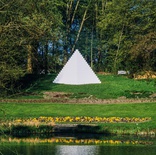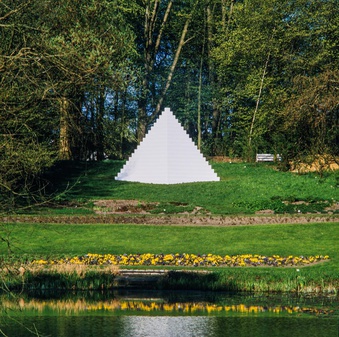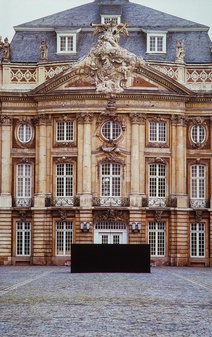Sol LeWitt
White Pyramid [Weiße Pyramide]
1987
Sculpture built of blocks of aerated concrete, painted white
510 x 510 x 510 cm
Location
Botanical Garden of Münster University. Temporary installation for the duration of Skulptur Projekte in Münster 1987, dismantled in April 1988
Owner
Private collection, USA
Black Form – Dedicated to the Missing Jews
1987
Sculpture built of blocks of aerated concrete, painted black
175 x 520 x 175 cm
Location
Schlossplatz
Temporary installation for the duration of Skulptur Projekte in Münster 1987, dismantled in February 1988; since 1989 the work has been installed in front of Altona Town Hall in Hamburg, Platz der Republik
Owner
City of Hamburg, donated by the artist in 1989
Sol LeWitt
* 1928 in Hartford, Connecticut, USA
† 2007 in New York, USA
In 1987 Sol LeWitt designed two sculptures made of aerated concrete blocks and installed them on the symmetry axis of Münster’s palace gardens. In the botanical garden he built a white, tiered pyramid that tapered to a point towards the western edge of its square base, reaching the same height as the breadth of its front side. In front of the palace the artist again used standard blocks to construct a black cube. The sculptures constituted a pair marked by opposites: white/black, complex/simple, embedded/resistant. In retrospect it seems that LeWitt had abandoned this idea of equivalence. In 2000 he was quoted in reference to Black Form: “I wanted to make a piece that was completely different from the lacy architecture behind it, so I made it in a sort of ungainly block. I wanted it to be hard to swallow in terms of form and completely antithetical to the site. Then I decided to make it even more antithetical by painting it black. Once that was done I thought, well I’ll give it a title that will make it even more unpalatable.”1
While White Pyramid followed seamlessly on from LeWitt’s oeuvre, Black Form through its title signalled a political statement, a unique instance in LeWitt’s work. “This was the only political art that I made and the only political thing about it was the title, but I thought I owed it to the Germans – and the Jews – to make one comment.”2 The idea that LeWitt was thereby seeking to extend the contradiction between both works into the realm of reception is appealing but speculative. In this sense one could nonetheless consider this an experiment on the impact of art in public spaces that continues to the present. In 1987 White Pyramid was greeted with general approval but since its removal it has largely been forgotten. Black Form, on the other hand, sparked controversy from the very start but was erected elsewhere immediately after being dismantled in 1988. Today it is still thought to embody an outstanding memorial concept.3
Eckhard Kluth
1 Cited in Martin Friedmann, “Construction Sights”, in: Gary Garrels (ed.), Sol LeWitt. A Retrospective, exhib. cat. San Francisco Museum of Art, San Francisco, 2000, pp. 49–59 (here: p. 50).
2 Ibid., p. 58.
3 Cf. Angeli C. F. Sachs, „Neue Formen der Erinnerung. Zwei Mahnmale von Jenny Holzer und Sol LeWitt in Deutschland“. In: Kunsttexte.de, Nr. 3/2002, online unter: http://edoc.hu-berlin.de/kunsttexte/download/kume/sachs.PDF (last consulted: 19.12.2016).
Location

Sol LeWitt
White Pyramid
None

Sol LeWitt
Black Form – Dedicated to the Missing Jews
None
- Still existing / Public Collection
- Removed
- In the museum
Other Participation
This artist also participated in: 1997

